21 Reasons 2014 Was the Best Year Ever for Tabletop Role-Playing Gamers
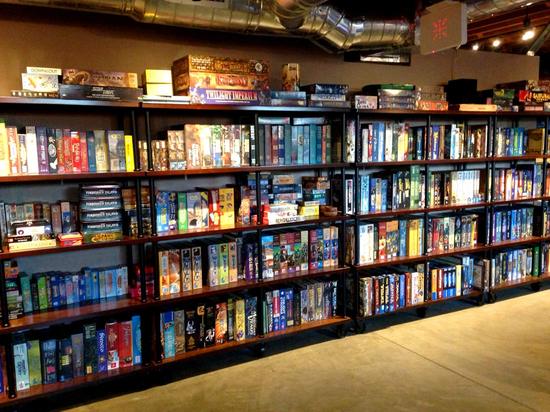 |
| GameHaus Cafe |
It is a golden age for fans of the tabletop gaming hobby. The past couple of years have seen an explosion of wonderful games and game related products and 2014 is the best so far. When the “Years it was Great to be a Gamer” Hall of Fame voters chose the years they will honor, 2014 will go down in history as the Babe Ruth of hobby gaming offering. Okay…if you consider Kickstarter as the hobby gaming equivalent of PEDs, it’s the Barry Bonds of years, but that’s something truly impressive. Unless you won the lottery, there were more products that are worth your time and money released last year than you have either the time or the money to enjoy. Even then, you probably wouldn’t have the time to enjoy them.
Putting together a list of the best hobby game, and game related, products of 2014 wasn’t an easy task. In order to make the list manageable, I gave myself three rules. First, I was going to group related products. Second, I allowed myself to select 21 products instead of a more reasonable 10. Third, I didn’t select any official Pathfinder gaming material. I created that third rule because if I didn’t, the list could have easily been filled with nothing but Pathfinder stuff. Paizo put out some great products this year, but Topless Robot readers already know that.
Here are 21 products I think made 2014 the best year ever to be a tabletop gamer.
21) Firefly (Margaret Weis Productions)
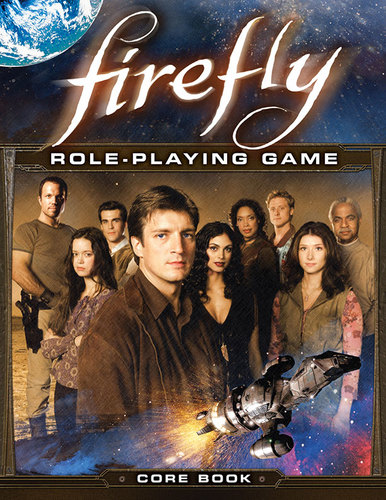 |
| Margaret Weis Productions |
In 2005, Margaret Weis Productions released the Serenity role-playing game which, due to some licensing oddities, was based on the film of the same name and not the Firefly television show. The Serenity game was the first game to use the Cortex game system, and the newness of that system showed a little around the edges; my first thought on playing Serenity was how similar the game play was to Savage Worlds. Given that I’d already done a couple of Savage Worlds conversions for Firefly characters, I used the Serenity game as more a sourcebook than as a game in itself.
Fast forward 9 years of game development, and the Cortex system, now the Cortex Plus system, has been tweaked and expanded into something completely its own. Since Serenity, the Margaret Weis team has used the Cortex system for the Leverage, Smallville, and Marvel Heroic roleplaying games. Each of those games stretched the rules and added depth to them. The Firefly Roleplaying Game continues the trend of developmental improvements to a good system. What sets Firefly apart from earlier Cortex Plus games is the way the mechanics are presented. Cortex Plus is a quirky (but really flexible) system and Monica Valentinelli and her team have streamlined the rules presentation and written a game that facilitates play as soon as possible. I’m particularly impressed with the way they teach you how to play by explaining episodes of the show in game terms. You get to read The Train Job while learning the basics of the combat system. It’s a nice conceit and it works very well.
20) Weird Wars Rome (Pinnacle Entertainment Group)
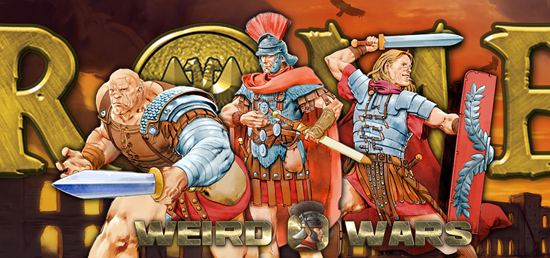 |
| Pinnacle Entertainment Group |
If you’ve read any of my earlier lists, then you know that I am a HUGE Savage Worlds fan. I’ve been on the Savage Bandwagon since I picked up the first edition of the game at the final Milwaukee Gen Con. The game’s commitment to pulp and high concept touch on all my favorite things about genre fiction and gaming. Pinnacle Entertainment Group released three new settings/games using the Savage Worlds system this year (Weird Wars Rome, East Texas University, and The Last Parsec), but if I could only buy one of them it would be Weird Wars Rome. There aren’t enough role-playing games that provide for “Sword and Sandals” adventures, and the addition of vampires, mummies, and werewolves to classic Roman mythology is a perfect recipe for adventure.
19) 13th Age Bestiary (Pelgrane Press)
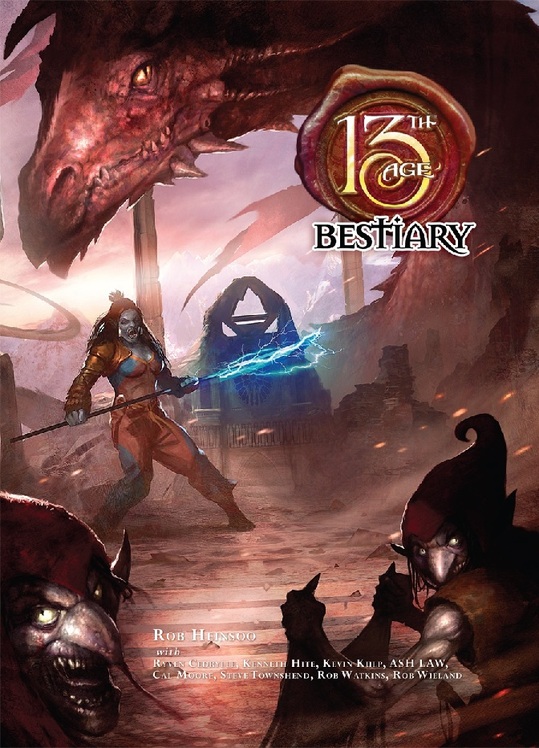 |
| DriveThruRPG |
The 13th Age Roleplaying Game combines everything I love about 4th Edition, throws away everything I don’t like about 4th Edition, and mixes it with a big dose of Feng Shui. It’s a game that is quick to play that allows you to feel like you are playing legendary heroes from moment one. It is the Dynasty Warriors – and I mean that in the best way – of role-playing games.
The 13th Age Bestiary exemplifies everything that is great about the system. Old school manuals of monstrous maleficence were little more than pretty spreadsheets with maybe a paragraph of description about the foes. They were like mail-order menus from which players would select the evening’s victims. Many modern manuals suffer from the same syndrome, but not the 13th Age Bestiary. This book is a wonder to behold and is useful as a resource for gamemasters no matter what system you are using. Each monster comes with adventure hooks, strategic advice and information about how the creature fits in the political frameworks of the 13th Age setting. This book, like the Threats to the Nentir Vale book for 4e, is a rich resource for storytelling.
18) Car Wars Classic (Steve Jackson Games)
“DRIVE OFFENSIVELY!”
I can still remember the first time I read those words on the back of a Car Wars Deluxe Edition boxed set in the mid-’80s. Car Wars was the first of several dystopian “drive around in cars and murder the other players” games, and it’s still the best. At the turn of the century – it feels odd typing those words – Steve Jackson Games published a new edition of the game that attempted to make the game easier to play, but the game lacked the rich vehicle construction rules that made the original Car Wars so special.
Car Wars Classic is two games. There is the game where you drive around shooting each other while driving on the highways, byways, and dueltracks of a post-apocalyptic America. Then there’s the game where you sit at your table/desk until 3 or 4 in the morning spending fictional dollars to build the ultimate murder machine inspired by many viewings of Death Race 2000. I don’t know which game is more fun, but I know that this new edition of Car Wars has brought them both back for a new generation of gamers.
17) Accursed (Melior Via)
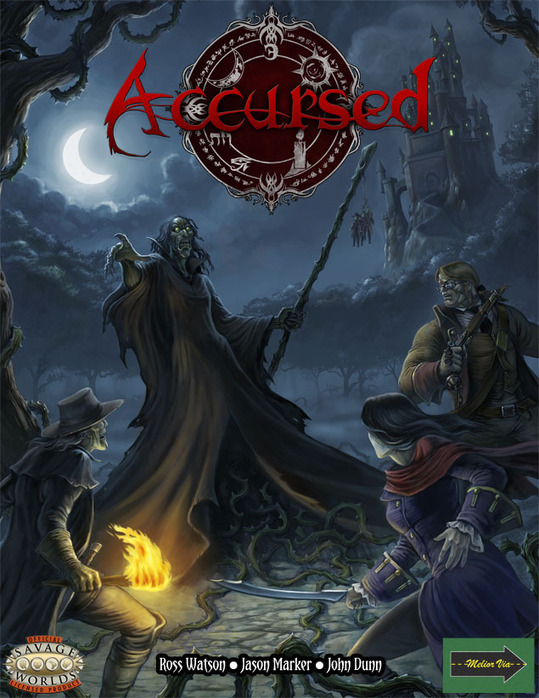 |
| Melior Via |
Melior Via’s Accursed setting for the Savage Worlds role playing game is everything Universal Studios should be doing with their relaunched Universal Monsters movies. Accursed combines high fantasy, fairy tales, the heroic action of the Underworld series of films, the dark self-loathing of the World of Darkness setting, and smashes it together with the pulpy goodness of the Creature Commandos. In the setting, you play people who were cursed by a coven of powerful witches to be the vanguard of their army as they conquered a once vibrant land. You have been recently freed from mental domination to find a world ruled by horrifying conquerors like Baba Yaga, a world without heroes to save it. Only you can save the people of Morden, but your murderous sins and your monstrous curse remain. Can you harness the talents of your curse without succumbing to temptation and becoming a servant of darkness once more?
16) Star Wars: Age of Rebellion (Fantasy Flight Games)
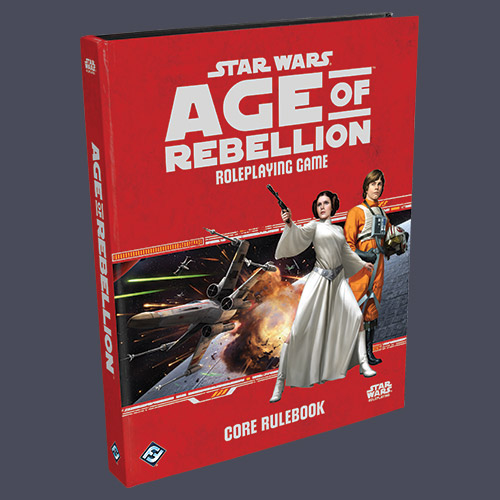 |
| Fantasy Flight Games |
Fantasy Flight Games released Star Wars: Edge of the Empire in 2013. The game expanded on the mechanics Fantasy Flight used in Warhammer Fantasy Roleplay 3rd Edition and made those mechanics simpler and more intuitive for game play. The game did well, and is a fun game, but what Star Wars gamer wants to spend all of their time on the edge of the Empire playing out tales of skullduggery, smuggling, and moisture farming? Not me, at least not before I saw the new series Rebels.
I want to pilot X-Wing fighters while attacking the Death Star, have lightsaber duels against Sith lords, and aid the Rebellion in their battle against the powerful Empire. I want to adventure in the world of the first trilogy and not slum around in the aether that exists between the first trilogy and the “prequels.” This year’s Star Wars: Age of Rebellion release allows me to do just that, and just in time to have a campaign going strong before the new J.J. Abrams movie. A film that will either guarantee a long lasting campaign filled with enthusiastic players, or force my group to abandon Star Wars gaming and replace it with sessions of Cyborg Commando.
15) Icons Assembled Edition (Green Ronin and Ad Infinitum Adventures)
| Green Ronin |
I love superhero role-playing games. No genre translates as seamlessly to the role-playing game hobby as the heroic adventures of comic book characters. Most of my favorite moments playing RPGs are from superhero adventures (Super Team Go!, “This Paul-Cano is about to erupt!”). There is only one small problem. Most superhero role playing games require hours upon hours of homework in order for players to be able to create the heroes they want to play and come to a basic level of proficiency with the combat rules. There are exceptions like the classic Marvel Super Heroes role-playing game, but those games often have oddities like a relatively lackluster combat system. Steve Kenson is a skilled game designer who has worked on a number of superhero role playing games, and his Icons: Assembled Edition is a gem. The game balances ease of play with a strong effort to capture the feel of comics of the Silver Age. If you are looking for a super hero game that you can pick up and play relatively quickly, this is the game for you.
14) Achtung! Cthulhu (Modiphius)
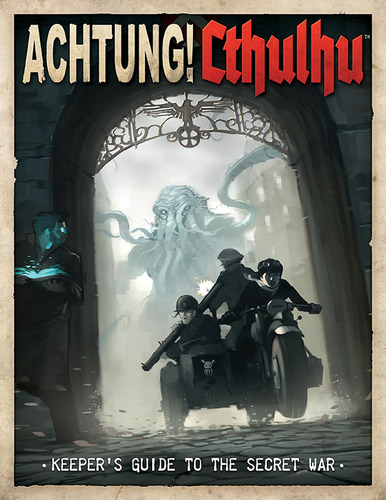 |
| Modiphius |
Nazis, cultists, mysticism and mayhem. What more could any gamer ask for? That the setting be available for the Savage Worlds, Call of Cthulhu, FATE, and GUMSHOE rules systems? Done. A line of products that will include close to a dozen setting and adventure books when all is said and done? Check.
While backers of the Achtung! Cthulhu Kickstarter received their game books last year, it wasn’t until 2014 that the gaming community at large was able to purchase this high concept action/horror setting. Taking place during the Second World War, the Achtung! Cthulhu setting provides an opportunity for a more action oriented campaign than your average Call of Cthulhu setting. Gamemasters can decide whether they want to run campaigns where player characters spiral into madness as in standard CoC play, or whether they want their game to feel more like Castle Wolfenstein. Achtung! Cthulhu can handle both styles of play, but the inclusion of Savage Worlds rules and FATE conversion materials demonstrates a bias toward more heroic action.
13) Deep Magic, Kobold Guide to Magic, Kobold Guide to Combat (Kobold Press)
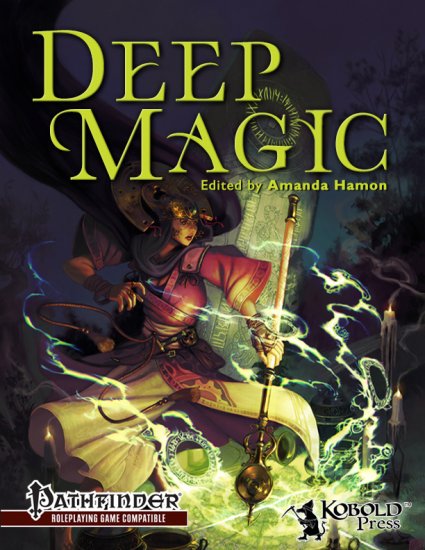 |
| Kobold Press |
I’ve been a supporter of Kobold Press since the first issue of Kobold Quarterly and was a Steam & Brass patron in the halcyon pre-Kickstarter crowdfunding days. To say I am a fan of their work is an understatement. Since the beginning, Kobold Press has been doing something very special for hobby gaming – they have been secretly training a future generation of game designers. Their OGL and Pathfinder compatible adventures have been well written, but more importantly, they have been community developed. Backers of Kobold Press adventures are a part of the creative process and the adventures themselves tend to implement creative mechanical twists.
This year Kobold Press stepped up their game design course offerings with Deep Magic, the Kobold Guide to Combat, and the Kobold Guide to Magic. At first glance, Deep Magic looks like a Pathfinder compatible sourcebook filled with spells and alternate magic systems. In reality, it is a crash course in house rule design. When you add the two Kobold Guides released this year – there are others from prior years – you have a set of course material that can aid any budding designer. While Deep Magic trains designers through example, the Kobold Guides are collections of thought pieces that inspire entirely new designs. I challenge any gamer to read the articles in either of the Kobold Guides to leave the reading without at least four ideas for entirely new games.
12) Pathfinder Legends(Paizo and Big Finish)
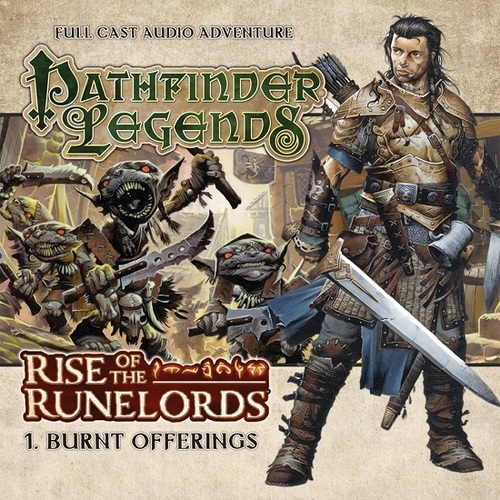 |
| Paizo |
I know that this technically breaks my earlier “no Pathfinder” rule, but when a company is successful enough that they can start to produce audio dramas based on their role-playing game, it deserves an exception. The first set of stories is based on the Rise of the Runelords adventure path series and is being produced by Big Finish who also produce Doctor Who and Blake’s 7 audio dramas. I find it interesting how often our hobby repeats itself while continually improving upon the past. In the before times, in the not now, TSR produced a series of audio dramas and included audio tracks for use in running adventures, but they lacked a connection to any of the underlying IP that TSR owned. While a werewolf drama might make for good fodder for stories, TSR fans would have rejoiced to hear a Ravenloft one.
You can listen to the audio trailer here. I cannot wait to listen to the adaptation of Hook Mountain Massacre, the Patfinder equivalent of Texas Chainsaw Massacre.
11) Torchbearer (Burning Wheel Headquarters)
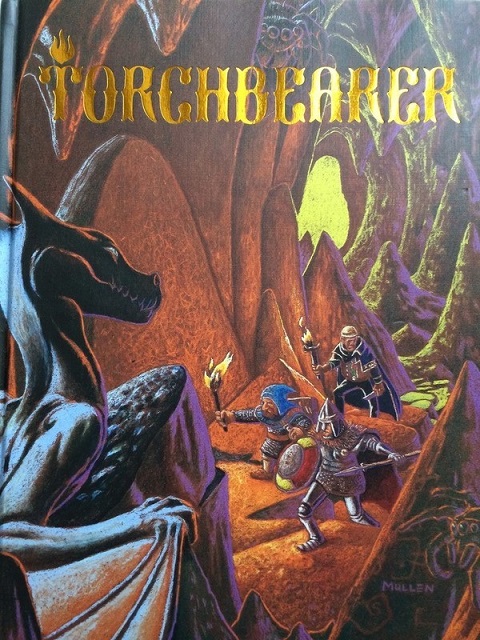 |
| Burning Wheel Headquarters |
While Torchbearer has been available to Kickstarter backers and Gen Con attendees since last year, it wasn’t until 2014 that the rulebook was made available to the wider gaming public. Torchbearer is an interesting experiment; an attempt to play old-school dungeon crawl adventures using a rule system designed for “post-gamist” play, it is a narrativist game emulating gamist play. It’s as if the kids who thought they had discovered a better way to play role-playing games discovered that the way people played at the beginning was worth playing, but that they didn’t want to learn new rules to play that way. And you know what? I’m glad that they did what they did.
Torchbearer is a great fusion of semi-modern indie game design, non-tactical game play preferences, and lethal dungeon crawls. For Old School gamers, it’s a great introduction to some of the mechanics being used in independent gaming circles, and for indie gamers it’s a great introduction to the kind of adventures people played at the start of the hobby and still play today. If Torchbearer gets more indie gamers to play classic games and more old-school gamers to play new games, it will have given the hobby a great gift.
10) Sentinel Tactics (Greater Than Games, LLC)
As is probably clear by many of my past posts, I’m a sucker for superhero games. I pride myself on the fact that I own almost every superhero roleplaying game ever published. (I used to claim to own them all, but the digital era has made this nigh-impossible.) There were two superhero tactical miniatures games released in 2014, but the one that gets the most buzz is Sentinel Tactics by Greater Than Games. Sentinel Tactics takes place in the same poorly drawn comic book universe as Sentinels of the Multiverse, and, like that game, is so fun that you can overlook the artwork. The combat system for Sentinel Tactics really captures the feel of superhero action and demonstrates how far boardgame design has come since the old Task Force Games boardgame Supervillains.
Greater Than Games has focused on gameplay, which is the most important thing in gaming, but I cannot help but think that if the graphic presentation of the game improved, this game would be a smash hit. My hope is that it will do well enough that the company will be able to hire some comic-book industry professionals to upgrade the art work. A top-notch superhero game should have top-notch art.
9) Imperial Assault (Fantasy Flight Games)
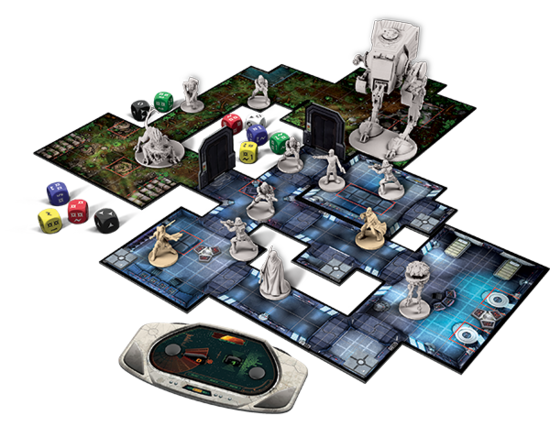 |
| Fantasy Flight Games |
It’s a skirmish game, it’s a campaign game, it’s based on Star Wars, and it’s published by the company that makes Descent. Imperial Assault almost didn’t make this list because it almost wasn’t released in 2014. If our editor at Topless Robot had run these best of lists at the beginning of December, rather than at the end, this game would have been overlooked because it wasn’t released until late this month. Let me tell you that it was well worth the wait. Typical of Fantasy Flight Games, at least since Runebound, the game uses special dice and has lots of tiny bits to keep track of. Also typical of Fantasy Flight Games, this game is fun to play and has very high quality components. Imperial Assault> uses a modified version of the rules from Descent, but with changes that reflect the Space Opera tone of the Star Wars movies. The basic game is currently available and the first quarter of 2015 will see several expansions released in rapid succession.
8) Shadows of Brimstone (Flying Frog Productions)
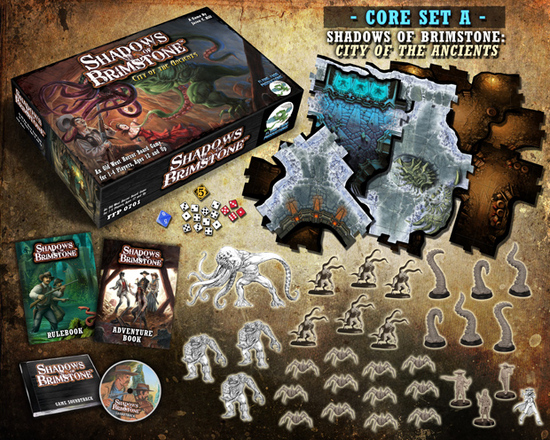 |
| Flying Frog Productions |
Flying Frog Productions has been releasing quality adventure boardgames since they released Last Night on Earth in 2007. When Last Night on Earth first came out, I was a bit skeptical. The zombie adventure game market was already pretty crowded at the time, though nowhere near as crowded as it is now, and I was convinced that When Darkness Comes was going to be my “go to” adventure horror game. I was wrong. Last Night on Earth had high quality components, easy to learn rules, a nice narrative tone, and…a soundtrack. Fast forward seven years and Flying Frog Productions has designed successful games in several genre: Modern Horror, Classic Horror, Alien Invasion, and Pulp Action. Each of these games covered a genre that had a number of alternatives, but Flying Frog kept finding fresh ways to present the ideas. What previously explored genre was left for them to conquer?
Western horror.
And they decided to do it by combining cowboys and Cthulhu. Cowboys and Cthulhu. A perfect combination of my favorite film genre with one of my favorite literary genres (though ironically “Cthulhu-based films” is my least favorite film genre). I am a huge Deadlands fan – speaking of Deadlands, the Doomtown card game saw a new edition in 2014 – so any game in this genre is going to meet with a highly critical eye. This game is very good. It enters into a highly competitive and saturated market, the “adventure board game,” and demonstrates how it can be done in fresh and interesting ways. Do yourself a favor. Travel back in time, rob a bank in Tombstone, AZ in the amount of $200, then use that money to buy both base sets of Shadows of Brimstone.
7) Adventure Maximus (Eden Studios)
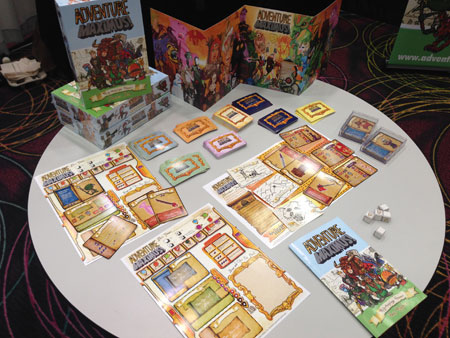 |
| Eden Studios |
I don’t know when the trend of designing introductory role-playing games aimed at kids was rekindled, but I’m willing to credit Susan J. Morris’ Monster Slayers, Enrique Bertran’s rpgKids, and Stan! for his Pokemon Jr. Adventure Game. Regardless of who is responsible for the revitalization of the game genre, the past couple of years have had some excellent entries. Last year’s Hero Kids is one of my favorite introductory role playing games, and now Francis Hogan’s Adventure Maximus can join that game on my list of must own games for gamers with kids.
Adventure Maximus has very simple game mechanics, but what sets it apart from prior entries in the kid-friendly role-playing game category is the toy factor. There are lots of little bits to play with here, and it’s clear that the designers had a lot of fun making this game. Not only that, it’s also clear that they’ve actually played this game with kids and haven’t designed it for what they think kids will like. I interviewed Francis Hogan about the game this summer and his excitement was contagious.
6) The Strange (Monte Cook Games)
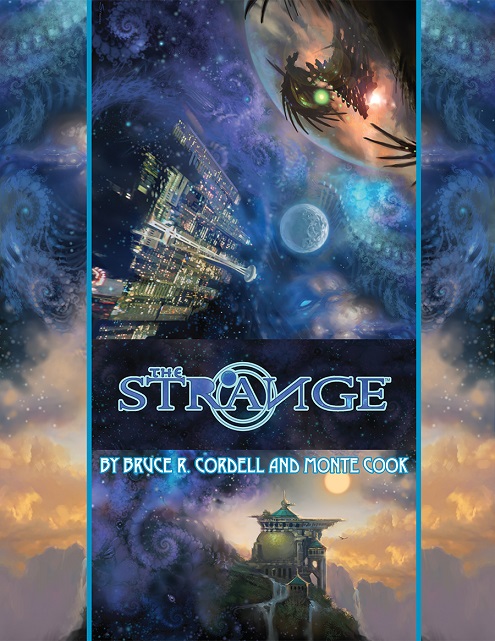 |
| The Strange RPG |
How do you generate $400,000 in sales in 30 days or less? Combine the names Monte Cook and Bruce R. Cordell and have them create an inventive science-fiction setting for a role-playing game using a Monte Cook designed system. The Strange is a role-playing game about alternate realities that exist beneath our own universe. Cook and Cordell have decades of game design experience between them and they bring their experience, as well as a distinct vision, to The Strange. Cook has long worked on weird settings filled with alternate dimensions; his Planescape work at TSR is among the best materials produced for 2nd Edition Advanced Dungeons & Dragons.
What makes The Strange so engaging is how the Cook and Cordell have stretched the Cypher System that Cook used in the Numenera game. The Strange is more than just a game that features numerous settings in alternate dimensions; the characters that the players use are different in each universe. I’ve only seen this kind of game attempted once before with the Amazing Engine and The Strange navigates the concept in a much simpler manner than that earlier game.
5) Call of Cthulhu 7th Edition (Chaosium)
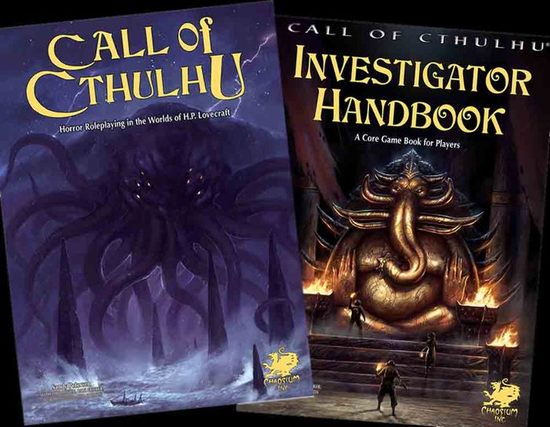 |
| Black Gate |
Call of Cthulhu is one of the oldest role-playing games on the market, and with its newest and 7th edition marks the first time in the game’s history that a new edition added significant changes to gameplay. Earlier editions included incremental changes, but the latest edition has made several which have been the topic of much forum discourse. One of the first changes the game made was the elimination of the “Resistance Table” which was used to determine the success of things like poisons in earlier editions. The system now uses opposed rolls for these kinds of actions, and in combat as well. While some players might not approve of the changes in the new edition, I find that most of them make a lot of sense and those that don’t can be completely ignored. For all intents and purposes, the game is 100% backward compatible.
If you want a glimpse of the changes in 7th edition, the good people at Chaosium have created a free Quick Play rulebook for your use.
4) Classified (Expeditious Retreat Press)
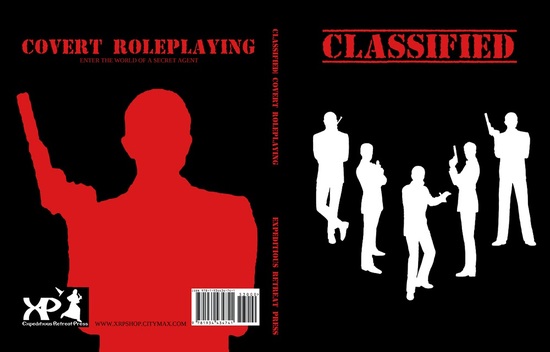 |
| Joseph Browning |
In the early 1980s, shortly after TSR bought SPI, a group of former SPI employees formed a design studio called Victory Games that was a subsidiary company of Avalon Hill. The story of the SPI acquisition is a complex one, and one where the truth of the matter is lost in a morass of gossip and mixed feelings. In the past, I’ve written a bit about that acquisition and about their game Dragonquest as well.
What is important for our conversation today is that when TSR purchased SPI, they purchased a lot of debt and watched as all the talent fled to form new companies. One of those companies was Victory Games, and they designed what I consider to be the best espionage role-playing game designed prior to Night’s Black Agents. That game was James Bond 007 and it was a market failure, but has influenced game design for decades. James Bond 007 had everything stacked against it.
First, it was a licensed game being designed in an era when licensed games were known for being terrible. Have you ever played SPI’s Dallas roleplaying game? If you have, then you know what I mean. Second, it was being designed by designers who hadn’t been particularly successful in creating easy to play RPGs in the past. SPI’s Dragonquest and Universe have their merits, but ease of play isn’t one of them. Even with those challenges, Victory Games managed to create a game that perfectly captured the espionage genre and that was easy to learn and played fast. Classified by Expeditious Press is a retro-clone of that original game and should be added to every gamer’s shelf…though you have to get the Lulu version to do that.
3) Designers and Dragons (Evil Hat Productions)
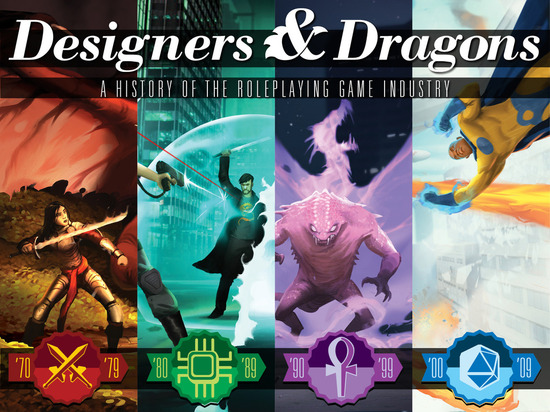 |
| Evil Hat Kickstarter |
So…you don’t trust my analysis of the TSR acquisition of SPI and you want to read another source without having to track down ancient copies of the Fire & Movement magazine? Then you might want to pick up Shannon Appelcline’s excellent history of the hobby, Designers and Dragons from Evil Hat Productions. Shannon’s work may lack the touch of the trained historian of Jon Peterson’s Playing at the World, but it is an invaluable resource to gamers everywhere. If you want to get an insider’s-eye view, then this series of books is for you. You can currently order the books in hardback from rpgnow.com, or you can get quality paperbacks from the Evil Hat Productions website and your friendly local game store.
The only reservation I would posit to readers is that Shannon is an active part of the roleplaying game publishing community and so he is very close to the material he is covering. This means that his own personal sense of people and product shapes the presentation of the history more than someone coming from a purely archival position. While this seems like a criticism, it isn’t. Shannon’s work here is extensive and meticulous. He has taken care to be as fair as he can be, but he is still a person of strong opinions. His skepticism regarding the 4th Edition of Dungeons & Dragons was evident in the Mongoose edition of this history, but this skepticism is transformed into an engaging narrative in the Evil Hat edition. Shannon’s ability to create an exciting narrative is one of the strengths of his close proximity to the action. His history may not be as academic as Peterson’s examination of the early days of the hobby, but it is a valuable work of history none the less.
2) A Red and Pleasant Land (Lamentations of the Flame Princess)
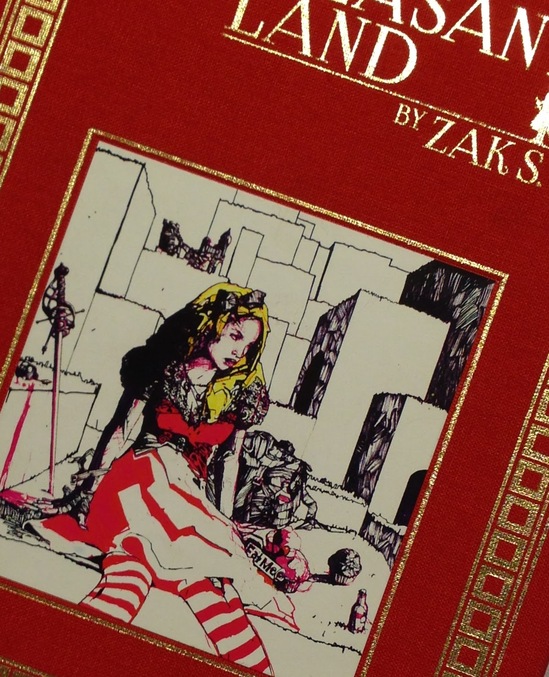 |
| Playing D&D with Pornstars |
A Red and Pleasant Land by Zak S. is a sign of the strength of the modern role-playing game hobby. While there have been disruptions in the economics of it all, books like A Red and Pleasant Land demonstrate how, even in times of turmoil, high-quality independent products that can be played using existing rules sets (or their retro-clones) are available. We are long past the era of the amateurish independently published product. Compare A Red and Pleasant Land, Torchbearer, and a host of other independent roleplaying games to what independent publishers were producing in the ’70s, ’80s, and ’90s – there is no comparison. The independent market is now filled with independent professionals. Zak S.’s success as a game designer is evident in the glowing reviews he has received from Kenneth Hite, Monte Cook, China Mi?ville, and Vanessa Veselka among others.
Speaking of Vanessa Veselka, one thing that I’ve noticed about Zak S.’s writing is that he loves his Vs. They are the Zak S. equivalent of superfluous apostrophes in Drow names. Let me give you a few examples. Zak S.’s other – completely indispensable – game product is titled Vornheim. An online city map for use in FlailSnails games includes the home of Count Leopold Von Vorg, and A Red and Pleasant Land features as an antagonist the Vampiric Viscount Vlad Vortigen of Voivodja. Okay, I made that last one up…the Viscount part anyway. All the other parts of that are there. There is a Vlad Vortigen of Voivodja, but I’m having unnecessary fun here.
Vs aside, this is one hell of a gaming supplement. Like Zak’s earlier work Vornheim, A Red and Pleasant Land is filled with tools that will enable game masters to tell engaging stories with very little prep time. Zak is the working game master’s best friend. He has either a random table or an innovative random method of answering any question a game master might need. In Vornheim he provided a remarkable system for creating city maps on the fly, and he provides a similarly useful tool in A Red and Pleasant Land for wilderness maps. Add to the utility of his material, high quality art that echoes the art of earlier versions of Alice in Wonderland, an imagination that successfully merges nursery rhymes, Alice in Wonderland, and horrific slavic folklore and you’ve got one of the best roleplaying supplements of the past decade.
The only genuine criticism I have of the book is that, like Kenneth Hite’s Qelong, it has only 2,000 copies being printed.
1) Dungeons and Dragons 5th Edition (Wizards of the Coast)
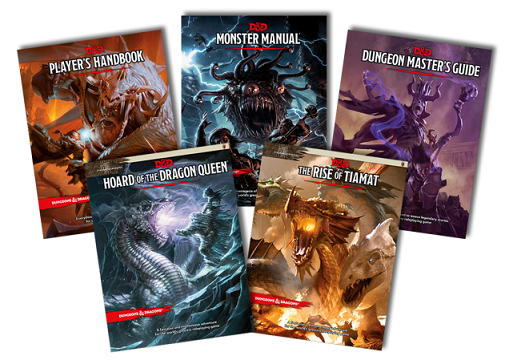 |
| Halfling’s Hideaway Games |
I can see you all rolling your eyes at this obvious choice, and I’d join with you if it weren’t for one small thing. The new edition of Dungeons and Dragons is fantastic. Not only does this edition of the game successfully combine what was successful in every earlier edition into one single new game system, it does so while returning the game to its classic feel. The rules to the 5th edition are filled with mechanics from every edition from 1st through 4th and some of the non-numbered editions as well. What is remarkable about this feat is that I would have thought it was impossible to do before reading these rules. As much as I like the 4th edition, and I do, I never really believed that it was “D&D in its DNA.” This new edition shows me how wrong I was by inserting 4th edition innovations seamlessly into a 1st edition framework. That’s an impressive feat of mechanical design.
Beyond mechanical innovation, though, this is an impressive product. The graphic design is up to the high standards of the modern hobby and the binding is top notch. What is most impressive about the game though is all the advice for players and Dungeon Masters. The new Dungeon Master’s Guide is one of the best resources for game masters I’ve ever read. It ranks up there with Aaron Allston’s Strike Force and the Pathfinder GameMastery Guide for the number of times I pull it out to read for advice or inspiration. Just go out and buy it already, but you probably already have.
Previously by Christian Lindke:
10 Geek Holidays and How to Celebrate Them
20 Questions with Wizards of the Coast’s D&D Development Team
7 Reasons I, Frankenstein Is Like the Greatest RPG Campaign Ever GM’d
The 10 Best Superhero Role-Playing Games
From The Adventures of Rocky and Bullwinkle to Dallas: 10 Strange Licensed RPGs
Ten Ways to Make a Dungeons & Dragons Movie Not Suck
Related Posts
-
The 10 Worst Episodes of Transformers
Transformers was one of those cartoon series with a general plot
-
11 Awesome Occult Detectives
?The detective genre has been around for at least three hundred
by Bri Buckley
About The Author
Christian Lindke
In between studying for a Ph.D. in Political Science at the University of California, Riverside and being a non-profit Program Director, Christian Lindke spends his time experiencing as much of pop culture as possible and playing role playing games. He hosts the Advanced Dungeons and Parenting Blog and holds an M.B.A. in Marketing.
